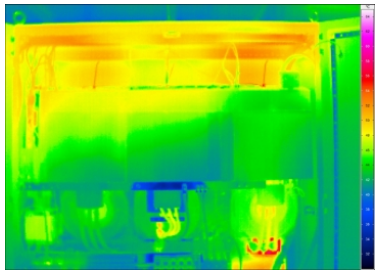Increase of the temperature in the control cabinet or condensation as a result may be the cause of failure. It is necessary to design an appropriate ventilation system in accordance with IEC 61439-1 at the very first stage of project for the control cabinet.
Higher temperature in the cabinet is often caused by components that are too tightly placed in the housing, which results either from the intended operation, for example miniaturization of control cabinets to save space, or from the situation when additional elements are added to the existing cabinet, and the housing remains unchanged.
TEMPERATURE DISTRIBUTION – reasons of temperature increase in the control cabinet
The temperature distribution in the control cabinet is not homogeneous and depends on various factors:
- 1. Elements that emit heat as a result of “losses” the most quickly heat up; this is the result of their construction and this is a normal situation. For example, the larger the inverter or servo drive is, the more heat will be released inside the cabinet.
- 2. The temperature inside the control cabinet will increase when:
- a. There is no adequate ventilation or air-conditioning system
- b. The control cabinet is too small in relation to the number of elements placed in it
- c. The outside temperature is not so low that the heat from inside the cabinet can be effectively released outside
- d. The planned electrical wires have too small cross-section in relation to the current flowing through, which may lead to heat up too much, and even cause a fire
e. There are too many wires planned in relation to the size of the control cabinet, placed tightly next to each other, making it difficult to properly discharge heat.
 Picture from: https://new.siemens.com/pl/pl.html
Picture from: https://new.siemens.com/pl/pl.html
ASSESSMENT OF TEMPERATURE DISTRIBUTION – what to pay attantion for?
When assessing the temperature distribution in the control cabinet, several factors must be taken into account:
- 1. Location of the cabinet: inside or outside the building
- 2. Location of the cabinet in the room: relative to walls and other objects
- 3. Power losses of elements contained in the housing
- 4. Dimensions and type of material from which the control cabinet was made of
- 5. Determine the temperature outside the cabinet
- 6. Determining the temperature inside the housing
- 7. Location of cooling elements
ASSESSMENT OF TEMPERATURE DISTRIBUTION – applied cooling solutions
- Ventilation grilles with filter
- Filter fans
- Heat exchangers
- Air conditioning
Do you know…?
Decreasing the temperature in the control cabinet by 5°C extends its lifetime by as much as 20%.*
*Source: Siemens



